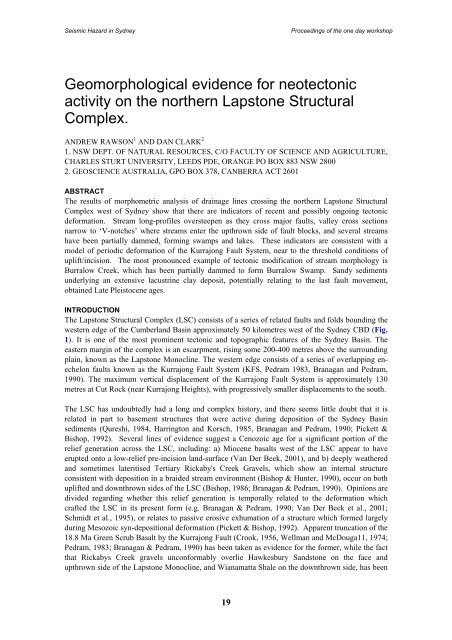Landslides in the Sydney Basin - Geoscience Australia
Landslides in the Sydney Basin - Geoscience Australia
Landslides in the Sydney Basin - Geoscience Australia
- No tags were found...
You also want an ePaper? Increase the reach of your titles
YUMPU automatically turns print PDFs into web optimized ePapers that Google loves.
Seismic Hazard <strong>in</strong> <strong>Sydney</strong>Proceed<strong>in</strong>gs of <strong>the</strong> one day workshopGeomorphological evidence for neotectonicactivity on <strong>the</strong> nor<strong>the</strong>rn Lapstone StructuralComplex.ANDREW RAWSON 1 AND DAN CLARK 21. NSW DEPT. OF NATURAL RESOURCES, C/O FACULTY OF SCIENCE AND AGRICULTURE,CHARLES STURT UNIVERSITY, LEEDS PDE, ORANGE PO BOX 883 NSW 28002. GEOSCIENCE AUSTRALIA, GPO BOX 378, CANBERRA ACT 2601ABSTRACTThe results of morphometric analysis of dra<strong>in</strong>age l<strong>in</strong>es cross<strong>in</strong>g <strong>the</strong> nor<strong>the</strong>rn Lapstone StructuralComplex west of <strong>Sydney</strong> show that <strong>the</strong>re are <strong>in</strong>dicators of recent and possibly ongo<strong>in</strong>g tectonicdeformation. Stream long-profiles oversteepen as <strong>the</strong>y cross major faults, valley cross sectionsnarrow to ‘V-notches’ where streams enter <strong>the</strong> upthrown side of fault blocks, and several streamshave been partially dammed, form<strong>in</strong>g swamps and lakes. These <strong>in</strong>dicators are consistent with amodel of periodic deformation of <strong>the</strong> Kurrajong Fault System, near to <strong>the</strong> threshold conditions ofuplift/<strong>in</strong>cision. The most pronounced example of tectonic modification of stream morphology isBurralow Creek, which has been partially dammed to form Burralow Swamp. Sandy sedimentsunderly<strong>in</strong>g an extensive lacustr<strong>in</strong>e clay deposit, potentially relat<strong>in</strong>g to <strong>the</strong> last fault movement,obta<strong>in</strong>ed Late Pleistocene ages.INTRODUCTIONThe Lapstone Structural Complex (LSC) consists of a series of related faults and folds bound<strong>in</strong>g <strong>the</strong>western edge of <strong>the</strong> Cumberland Bas<strong>in</strong> approximately 50 kilometres west of <strong>the</strong> <strong>Sydney</strong> CBD (Fig.1). It is one of <strong>the</strong> most prom<strong>in</strong>ent tectonic and topographic features of <strong>the</strong> <strong>Sydney</strong> Bas<strong>in</strong>. Theeastern marg<strong>in</strong> of <strong>the</strong> complex is an escarpment, ris<strong>in</strong>g some 200-400 metres above <strong>the</strong> surround<strong>in</strong>gpla<strong>in</strong>, known as <strong>the</strong> Lapstone Monocl<strong>in</strong>e. The western edge consists of a series of overlapp<strong>in</strong>g enechelonfaults known as <strong>the</strong> Kurrajong Fault System (KFS, Pedram 1983, Branagan and Pedram,1990). The maximum vertical displacement of <strong>the</strong> Kurrajong Fault System is approximately 130metres at Cut Rock (near Kurrajong Heights), with progressively smaller displacements to <strong>the</strong> south.The LSC has undoubtedly had a long and complex history, and <strong>the</strong>re seems little doubt that it isrelated <strong>in</strong> part to basement structures that were active dur<strong>in</strong>g deposition of <strong>the</strong> <strong>Sydney</strong> Bas<strong>in</strong>sediments (Qureshi, 1984, Harr<strong>in</strong>gton and Korsch, 1985, Branagan and Pedram, 1990; Pickett &Bishop, 1992). Several l<strong>in</strong>es of evidence suggest a Cenozoic age for a significant portion of <strong>the</strong>relief generation across <strong>the</strong> LSC, <strong>in</strong>clud<strong>in</strong>g: a) Miocene basalts west of <strong>the</strong> LSC appear to haveerupted onto a low-relief pre-<strong>in</strong>cision land-surface (Van Der Beek, 2001), and b) deeply wea<strong>the</strong>redand sometimes lateritised Tertiary Rickaby's Creek Gravels, which show an <strong>in</strong>ternal structureconsistent with deposition <strong>in</strong> a braided stream environment (Bishop & Hunter, 1990), occur on bothuplifted and downthrown sides of <strong>the</strong> LSC (Bishop, 1986; Branagan & Pedram, 1990). Op<strong>in</strong>ions aredivided regard<strong>in</strong>g whe<strong>the</strong>r this relief generation is temporally related to <strong>the</strong> deformation whichcrafted <strong>the</strong> LSC <strong>in</strong> its present form (e.g. Branagan & Pedram, 1990; Van Der Beek et al., 2001;Schmidt et al., 1995), or relates to passive erosive exhumation of a structure which formed largelydur<strong>in</strong>g Mesozoic syn-depositional deformation (Pickett & Bishop, 1992). Apparent truncation of <strong>the</strong>18.8 Ma Green Scrub Basalt by <strong>the</strong> Kurrajong Fault (Crook, 1956, Wellman and McDouga11, 1974;Pedram, 1983; Branagan & Pedram, 1990) has been taken as evidence for <strong>the</strong> former, while <strong>the</strong> factthat Rickabys Creek gravels unconformably overlie Hawkesbury Sandstone on <strong>the</strong> face andupthrown side of <strong>the</strong> Lapstone Monocl<strong>in</strong>e, and Wianamatta Shale on <strong>the</strong> downthrown side, has been19
















